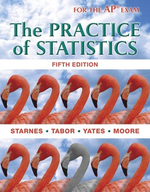Solution Found!
Solution: Section II: Free Response Show all your work. Indicate clearly the methods you
Chapter 4, Problem AP1.17(choose chapter or problem)
Section II: Free Response Show all your work. Indicate clearly the methods you use, because you will be graded on the correctness of your methods as well as on the accuracy and completeness of your results and explanations. In retail stores, there is a lot of competition for shelf space. There are national brands for most products, and many stores carry their own line of in-house brands, too. Since shelf space is not infinite, the question is how many linear feet to allocate to each product and which shelf (top, bottom, or somewhere in the middle) to put it on. The middle shelf is the most popular and lucrative, because many shoppers, if undecided, will simply pick the product that is at eye level. A local store that sells many upscale goods is trying to determine how much shelf space to allocate to its own brand of mens personal-grooming products. The middle shelf space is randomly varied between 3 and 6 linear feet over the next 12 weeks, and weekly sales revenue (in dollars) from the stores brand of personal-grooming products for men is recorded. Below is some computer output from the study, along with a scatterplot. Predictor Coef SE Coef T P Constant 317.94 31.32 10.15 0.000 Shelf length 152.680 6.445 23.69 0.000 S = 22.9212 R-Sq = 98.2% R-Sq(adj) = 98.1% (a) Describe the relationship between shelf length and sales. (b) Write the equation of the least-squares regression line. Be sure to define any variables you use. (c) If the store manager were to decide to allocate 5 linear feet of shelf space to the stores brand of mens grooming products, what is the best estimate of the weekly sales revenue? (d) Interpret the value of s. (e) Identify and interpret the coefficient of determination. (f) The store manager questions the intercept of the regression line: Am I supposed to believe that this analysis tells me that I can sell these products with no shelf space? How do you answer her?
Questions & Answers
QUESTION:
Section II: Free Response Show all your work. Indicate clearly the methods you use, because you will be graded on the correctness of your methods as well as on the accuracy and completeness of your results and explanations. In retail stores, there is a lot of competition for shelf space. There are national brands for most products, and many stores carry their own line of in-house brands, too. Since shelf space is not infinite, the question is how many linear feet to allocate to each product and which shelf (top, bottom, or somewhere in the middle) to put it on. The middle shelf is the most popular and lucrative, because many shoppers, if undecided, will simply pick the product that is at eye level. A local store that sells many upscale goods is trying to determine how much shelf space to allocate to its own brand of mens personal-grooming products. The middle shelf space is randomly varied between 3 and 6 linear feet over the next 12 weeks, and weekly sales revenue (in dollars) from the stores brand of personal-grooming products for men is recorded. Below is some computer output from the study, along with a scatterplot. Predictor Coef SE Coef T P Constant 317.94 31.32 10.15 0.000 Shelf length 152.680 6.445 23.69 0.000 S = 22.9212 R-Sq = 98.2% R-Sq(adj) = 98.1% (a) Describe the relationship between shelf length and sales. (b) Write the equation of the least-squares regression line. Be sure to define any variables you use. (c) If the store manager were to decide to allocate 5 linear feet of shelf space to the stores brand of mens grooming products, what is the best estimate of the weekly sales revenue? (d) Interpret the value of s. (e) Identify and interpret the coefficient of determination. (f) The store manager questions the intercept of the regression line: Am I supposed to believe that this analysis tells me that I can sell these products with no shelf space? How do you answer her?
ANSWER:Step 1 of 6
a)
DIRECTION=Positive, because the pattern in the scatterplot slopes upwards.
FORM=Linear, because there is no strong curvature present in the scatterplot
STRENGTH=Strong, because the points in the scatterplot do not deviate much from the general pattern in the points and the points are not spread very far within this general pattern.
UNUSUAL FEATURES=No outliers, because there appear to be no points that deviate strongly from the general pattern in the data.
Thus there is a strong, positive, linear relationship between shelf length and sales.
